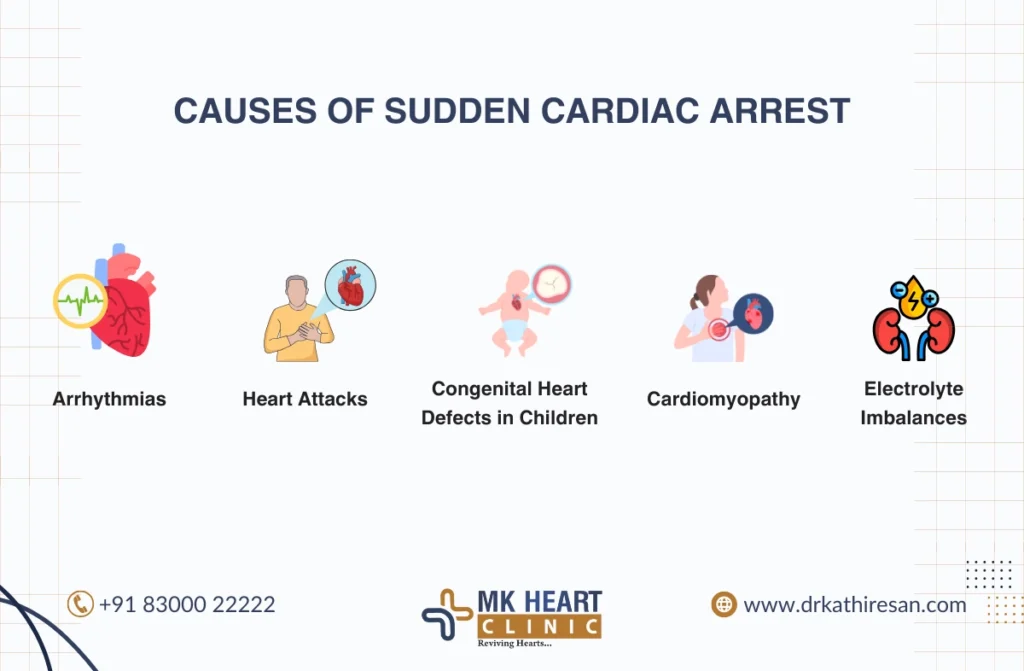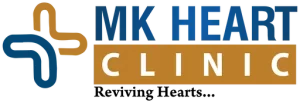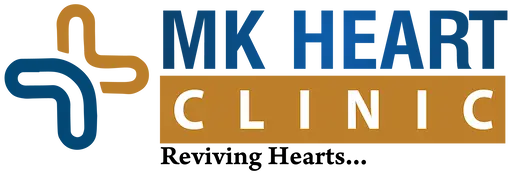Sudden Cardiac Arrest is a critical and life-threatening condition that demands immediate medical attention. Dr. M. Kathiresan, a highly regarded cardiac specialist, explains that understanding the causes, symptoms, and treatments of this condition can significantly increase survival rates. This blog will also address related topics, such as chest pain in children, exploring whether children can have heart attacks, and highlighting the importance of recognizing congenital heart defects in children.
What Is Cardiac Arrest?
Cardiac Arrest occurs when the heart abruptly stops beating due to a malfunction in its electrical system. This interruption prevents blood from flowing to vital organs, including the brain, lungs, and other tissues, leading to loss of consciousness and, if not treated immediately, death.
Unlike a heart attack, which is caused by blockages in blood vessels, Cardiac Arrest is primarily triggered by irregular heart rhythms, known as arrhythmias. Immediate intervention, such as CPR and defibrillation, is crucial to restoring heart function.

How Common Is Sudden Cardiac Arrest?
Cardiac Arrest is one of the leading causes of death globally. It affects millions each year, often without warning. While it predominantly impacts adults over 40, children and adolescents with undiagnosed heart conditions can also experience it.
Awareness of risk factors and early diagnosis can play a vital role in prevention.
Symptoms of Sudden Cardiac Arrest
- Abrupt loss of consciousness: The person suddenly faints or becomes unresponsive due to a lack of blood flow to the brain, often without any prior warning signs.
- Absence of a pulse or breathing: The heart stops beating effectively, leading to a complete halt in blood circulation, resulting in no detectable pulse or respiratory movements.
- Sudden collapse: The affected person may fall to the ground unexpectedly and remain motionless, unable to respond to external stimuli or regain consciousness.
- Gasping or abnormal breathing: In some cases, the individual may experience agonal breathing, which appears as gasping or irregular, labored breaths before complete respiratory failure.
- Chest discomfort or pain (in some cases): Although not always present, some individuals might experience chest pain, pressure, or discomfort just before collapsing.
- Seizure-like movements: The lack of oxygen supply to the brain can sometimes cause involuntary jerking movements, resembling a seizure.
- Pale or bluish skin color: Due to the sudden drop in oxygen levels, the person’s skin may turn pale, gray, or develop a bluish tint, especially around the lips and fingertips.
- No response to stimuli: The person does not react to shouting, touch, or any attempts to wake them up, indicating a complete loss of consciousness.
In some cases, individuals may experience warning signs before the event, such as chest discomfort, dizziness, or shortness of breath. Recognizing these signs early can save lives.
Causes of Sudden Cardiac Arrest
- Arrhythmias: Irregular heart rhythms disrupt the heart’s ability to pump blood effectively.
- Heart attacks: A prior heart attack can lead to scarring and electrical instability.
- Congenital heart defects in children: Structural abnormalities present at birth increase risk.
- Cardiomyopathy: A weakened heart muscle may lead to arrhythmias.
- Electrolyte imbalances: Issues with potassium or magnesium levels can interfere with electrical signals in the heart.
Risk Factors for Sudden Cardiac Arrest
- People with a family history of cardiac conditions.
- Those with high blood pressure, diabetes, or prior heart attacks.
- Children with congenital heart defects or genetic predispositions.
Chest Pain in Children: Should You Worry?
Parents often become anxious when their child reports chest pain in children. Fortunately, most cases are not linked to serious heart issues.
Common Causes of Chest Pain in Children:
- Muscle Strain: Physical activity or injuries are frequent culprits.
- Respiratory Problems: Asthma or infections can cause tightness in the chest.
- Gastroesophageal Reflux Disease (GERD): Acid reflux may mimic chest pain.
Parents should monitor their child’s symptoms closely and consult a doctor if the pain is severe, persistent, or accompanied by fainting or difficulty breathing.
Can Children Have Heart Attacks?
The question Can children have heart attacks? is often raised by concerned parents. While heart attacks in children are extremely rare, they are not impossible.
Why Would a Child Have a Heart Attack?
- Congenital heart defects in children: Structural abnormalities increase the risk.
- Inflammatory Conditions: Diseases like Kawasaki disease can affect coronary arteries.
- Clotting Disorders: These can lead to blockages in the blood vessels.
If parents wonder, Can children have heart attacks?, it’s important to recognize that lifestyle factors are rarely the cause. Instead, most cases involve genetic or congenital issues.
Understanding Congenital Heart Defects in Children
The abnormalities in the heart’s structure that develop before birth. These defects can range from minor conditions that resolve on their own to severe issues requiring surgical intervention.
Types of Congenital Heart Defects:
- Atrial Septal Defects (ASD): A hole in the wall separating the heart’s upper chambers.
- Ventricular Septal Defects (VSD): A hole between the heart’s lower chambers.
- Tetralogy of Fallot: A combination of four heart defects that affect oxygen flow.
Symptoms often include difficulty breathing, poor feeding, and bluish skin in newborns.
Complications of Sudden Cardiac Arrest
- Brain Damage: Lack of oxygen for even a few minutes can cause irreversible harm.
- Permanent Disability: If blood flow is not restored quickly, other organs may suffer damage.
- Death: In the absence of CPR or defibrillation, survival is unlikely.
Diagnosing Sudden Cardiac Arrest
Diagnosis focuses on determining the underlying cause. Tests include:
- Electrocardiograms (ECG): To Detect Arrhythmias and Electrical Abnormalities – An electrocardiogram (ECG) is a critical diagnostic tool that records the electrical activity of the heart, helping to identify irregular heart rhythms (arrhythmias), conduction disorders, or signs of previous heart attacks. It provides real-time insights into potential disturbances in heart function.
- Echocardiograms: To Assess Structural Abnormalities and Heart Function – An echocardiogram is an ultrasound imaging test that evaluates the heart’s structure, size, and pumping efficiency. It helps detect conditions such as heart valve disease, cardiomyopathy, or congenital heart defects that may contribute to abnormal cardiac activity. This test provides detailed visuals of heart chambers and assesses ejection fraction, an important measure of heart performance.
- Blood Tests: To Check for Markers of Heart Damage and Underlying Conditions – Blood tests help detect biochemical markers that indicate heart stress or damage. Troponin levels are measured to assess possible heart muscle injury, while electrolyte tests check for imbalances like potassium or calcium deficiencies that can trigger arrhythmias. Additional tests may include cholesterol levels, thyroid function, and markers of inflammation, all of which contribute to cardiac health.
Treatment for Sudden Cardiac Arrest
Treatment aims to restore heart function and prevent recurrence:
- Immediate Action: CPR and Defibrillation Are Essential – The first and most critical step in treating sudden cardiac arrest is performing cardiopulmonary resuscitation (CPR) immediately to maintain blood circulation and oxygen supply to vital organs. This should be followed by the use of an automated external defibrillator (AED) to deliver an electric shock to the heart, helping to restore a normal rhythm. Prompt action within the first few minutes significantly increases the chances of survival.
- Medications: Drugs to Stabilize Heart Rhythms – Various medications, including antiarrhythmic drugs, beta-blockers, and vasopressors, may be administered in a hospital setting to regulate heart rhythms and prevent further episodes. Epinephrine is commonly used during resuscitation efforts to support heart function, while amiodarone or lidocaine may be given to control irregular heartbeats.
- Implantable Devices: Pacemakers or Defibrillators for Long-Term Management – Patients at high risk of recurrent cardiac arrest may require an implantable cardioverter defibrillator (ICD), a small device placed under the skin that continuously monitors heart rhythms and delivers corrective shocks when abnormal activity is detected. In some cases, a pacemaker may also be recommended to regulate slow or irregular heartbeats, ensuring the heart functions properly.
What Should You Do About Your Child’s Chest Pain?
If your child reports chest pain, follow these steps:
- Stay Calm: Panic can worsen the situation.
- Assess Symptoms: Note any accompanying signs like fainting or difficulty breathing.
- Consult a Doctor: Seek medical attention if the pain persists or worsens.
Conclusion
Sudden Cardiac Arrest is a condition that requires immediate awareness and action. Understanding the symptoms, causes, and treatments can save lives. Dr. M. Kathiresan emphasizes the importance of recognizing related concerns and addressing whether children can have heart attacks, especially those with congenital heart defects in children.

